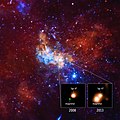File:Magnetar-SGR1745-2900-20150515.jpg

Original file (3,600 × 3,600 pixels, file size: 3.55 MB, MIME type: image/jpeg)
| This is a file from the Wikimedia Commons. Information from its description page there is shown below. Commons is a freely licensed media file repository. You can help. |
Summary
| DescriptionMagnetar-SGR1745-2900-20150515.jpg |
English: In 2013, astronomers announced they had discovered a magnetar exceptionally close to the supermassive black hole at the center of the Milky Way using a suite of space-borne telescopes including NASA’s Chandra X-ray Observatory.
Magnetars are dense, collapsed stars (called “neutron stars”) that possess enormously powerful magnetic fields. At a distance that could be as small as 0.3 light years (or about 2 trillion miles) from the 4-million-solar mass black hole in the center of our Milky Way galaxy, the magnetar is by far the closest neutron star to a supermassive black hole ever discovered and is likely in its gravitational grip. Since its discovery two years ago when it gave off a burst of X-rays, astronomers have been actively monitoring the magnetar, dubbed SGR 1745-2900, with Chandra and the European Space Agency’s XMM-Newton. The main image of the graphic shows the region around the Milky Way’s black hole in X-rays from Chandra (red, green, and blue are the low, medium, and high-energy X-rays respectively). The inset contains Chandra’s close-up look at the area right around the black hole, showing a combined image obtained between 2005 and 2008 (left) when the magnetar was not detected, during a quiescent period, and an observation in 2013 (right) when it was caught as a bright point source during the X-ray outburst that led to its discovery. A new study uses long-term monitoring observations to reveal that the amount of X-rays from SGR 1745-2900 is dropping more slowly than other previously observed magnetars, and its surface is hotter than expected. The team first considered whether “starquakes” are able to explain this unusual behavior. When neutron stars, including magnetars, form, they can develop a tough crust on the outside of the condensed star. Occasionally, this outer crust will crack, similar to how the Earth’s surface can fracture during an earthquake. Although starquakes can explain the change in brightness and cooling seen in many magnetars, the authors found that this mechanism by itself was unable to explain the slow drop in X-ray brightness and the hot crustal temperature.. Fading in X-ray brightness and surface cooling occur too quickly in the starquake model. The researchers suggest that bombardment of the surface of the magnetar by charged particles trapped in twisted bundles of magnetic fields above the surface may provide the additional heating of the magnetar’s surface, and account for the slow decline in X-rays. These twisted bundles of magnetic fields can be generated when the neutron star forms. The researchers do not think that the magnetar’s unusual behavior is caused by its proximity to a supermassive black hole, as the distance is still too great for strong interactions via magnetic fields or gravity. Astronomers will continue to study SGR 1745-2900 to glean more clues about what is happening with this magnetar as it orbits our galaxy’s supermassive black hole. These results appear in Monthly Notices of the Royal Astronomical Society in a paper led by the PhD student Francesco Coti Zelati (Universita’ dell’ Insubria, University of Amsterdam, INAF-OAB), within a large international collaboration. NASA's Marshall Space Flight Center in Huntsville, Alabama, manages the Chandra program for the agency’s Science Mission Directorate in Washington. The Smithsonian Astrophysical Observatory in Cambridge, Massachusetts, controls Chandra's science and flight operations. |
| Date | |
| Source | http://www.nasa.gov/mission_pages/chandra/magnetar-near-supermassive-black-hole-delivers-surprises.html |
| Author | NASA/CXC/INAF/F. Coti Zelati et al. |
Licensing
| Public domainPublic domainfalsefalse |
| This file is in the public domain in the United States because it was solely created by NASA. NASA copyright policy states that "NASA material is not protected by copyright unless noted". (See Template:PD-USGov, NASA copyright policy page or JPL Image Use Policy.) |  | |
 |
Warnings:
|
Captions
Items portrayed in this file
depicts
23 September 2014
image/jpeg
File history
Click on a date/time to view the file as it appeared at that time.
| Date/Time | Thumbnail | Dimensions | User | Comment | |
|---|---|---|---|---|---|
| current | 14:08, 15 May 2015 |  | 3,600 × 3,600 (3.55 MB) | Drbogdan | User created page with UploadWizard |
File usage
Global file usage
The following other wikis use this file:
- Usage on af.wikipedia.org
- Usage on el.wikipedia.org
- Usage on es.wiktionary.org
- Usage on ja.wikipedia.org
- Usage on ka.wikipedia.org
- Usage on pt.wikipedia.org
- Usage on zh.wikipedia.org
Metadata
This file contains additional information, probably added from the digital camera or scanner used to create or digitize it.
If the file has been modified from its original state, some details may not fully reflect the modified file.
| Author | Chandra X-ray Observatory Center |
|---|---|
| Source | Chandra X-ray Observatory |
| Usage terms | |
| Width | 3,600 px |
| Height | 3,600 px |
| Bits per component |
|
| Compression scheme | LZW |
| Pixel composition | RGB |
| Orientation | Normal |
| Number of components | 3 |
| Horizontal resolution | 300 dpi |
| Vertical resolution | 300 dpi |
| Data arrangement | chunky format |
| Software used | Adobe Photoshop CC 2014 (Macintosh) |
| File change date and time | 12:30, 13 May 2015 |
| Exif version | 2.21 |
| Color space | sRGB |
| Date and time of digitizing | 12:52, 23 September 2014 |
| Date metadata was last modified | 07:30, 13 May 2015 |
| Rating (out of 5) | 0 |
| Unique ID of original document | 4CB4E53C10E28FA4895D0EBBC8579AD6 |
| Copyright status | Copyright status not set |
| Contact information | cxcpub@cfa.harvard.edu
60 Garden St. Cambridge, MA, 02138 USA |
| IIM version | 4 |
